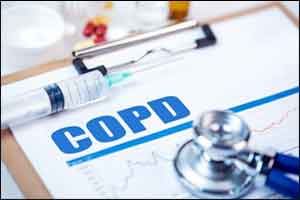- Home
- Editorial
- News
- Practice Guidelines
- Anesthesiology Guidelines
- Cancer Guidelines
- Cardiac Sciences Guidelines
- Critical Care Guidelines
- Dentistry Guidelines
- Dermatology Guidelines
- Diabetes and Endo Guidelines
- Diagnostics Guidelines
- ENT Guidelines
- Featured Practice Guidelines
- Gastroenterology Guidelines
- Geriatrics Guidelines
- Medicine Guidelines
- Nephrology Guidelines
- Neurosciences Guidelines
- Obs and Gynae Guidelines
- Ophthalmology Guidelines
- Orthopaedics Guidelines
- Paediatrics Guidelines
- Psychiatry Guidelines
- Pulmonology Guidelines
- Radiology Guidelines
- Surgery Guidelines
- Urology Guidelines
Targeted lung denervation new safe treatment for COPD

Results from the AIRFLOW 2 phase II clinical trial have shown that a technique called Targeted Lung Denervation (TLD) involving the opening of obstructed airways, has reduced chronic obstructive pulmonary disease (COPD) problems by more than 50% in patients who received the active treatment compared to patients who received the sham treatment and is safe.
Principal investigator Dr. Dirk-Jan Slebos, from the University Medical Centre Groningen, Netherlands, presented findings of the study at the European Respiratory Society International Congress.
"We have been able to significantly reduce chronic respiratory symptoms such as shortness of breath, exacerbations of the disease, infections, and hospitalizations in a group of COPD patients who are already on aggressive medical therapy. There was also a trend towards improved quality of life and better lung function in the treated patients. This has important implications for patient quality of life, and also healthcare costs, as these are events that have a significant impact on the cost of caring for these patients," he said.
TLD involves passing a special catheter through an instrument called a bronchoscope into the lungs. The bronchoscope allows doctors to see the inside of a patient's airways and to use the catheter to deliver a type of electrical charge called radiofrequency energy to the nerves on the outside of the airways, interrupting their normal function. This causes the airways to relax and widen, decreases mucus production and decreases airway wall inflammation. Then the catheter and bronchoscope are removed.
Also Read: More than 40% women with asthma may develop COPD
In the trial, taking place in several centers in six European countries, the patients were randomized to receive either LD or a sham procedure under general anesthetic. The sham procedure involved the insertion of the bronchoscope and catheter, but the radiofrequency electrical change is not delivered. This is performed under "double-blind" conditions, in which the treatment team that is carrying out the procedure knows whether the patient is assigned to the active treatment or the sham, but the follow-up team who sees the patient for post-procedure visits and tests does not, and nor does the patient.
TLD acts by targeting a well-known pathway involved in the development of COPD, called the cholinergic pathway, which regulates the body's inflammatory responses to injury and promotes smooth muscle constriction of the airways.
Anti-cholinergic drugs, which are often used to treat COPD, also target this pathway, but when they are combined with TLD there appears to be an additional, beneficial effect, even in patients who are being heavily treated with other drugs. Patients in both parts of the trial received tiotropium, an anticholinergic bronchodilator.
Dr. Slebos presented results from 82 patients in the trial at the ERS Congress. Half of them were male and they had an average age of nearly 64 years.
Key Findings of the Trial:
- Three to six months after the treatment, 71% of patients who had received the sham treatment had an adverse respiratory event related to COPD compared to 32% of patients who received the TLD treatment.
- None of the patients died and there were no TLD-related adverse side effects that needed to be treated.
- Five patients (12%) who received the TLD treatment experienced stomach problems such as nausea, abdominal bloating and digestion discomfort, but these were temporary symptoms that had gone after six months.
- the positive benefit has continued in those receiving TLD treatment, with the number of patients hospitalized for respiratory complications in the first year reduced by more than half in the treatment arm versus the sham arm.
"These occurred because of the radiofrequency energy affecting the nerves lining the nearby gullet," said Dr. Slebos. "We are improving our process and imaging in order to better understand where these gastric nerves are, and we have implemented additional measures to improve our ability to avoid them in future procedures."
Dr. Slebos said: "The results I am presenting today suggest that TLD can be an additional treatment option for COPD patients who are already receiving the optimum drug treatment for their symptoms. It offers the ability to significantly reduce symptoms and exacerbations even in patients already on aggressive medical therapy.
"With the addition of AIRFLOW-3, which will have a similar design but will include many more patients, there will be a profound amount of evidence for the procedure, gathered in a highly scientifically rigorous manner."
"After proving safety and feasibility in earlier trials, we felt a double-blind, randomized, sham-controlled trial would be an important scientific control to demonstrate the effectiveness of the treatment."

Disclaimer: This site is primarily intended for healthcare professionals. Any content/information on this website does not replace the advice of medical and/or health professionals and should not be construed as medical/diagnostic advice/endorsement or prescription. Use of this site is subject to our terms of use, privacy policy, advertisement policy. © 2020 Minerva Medical Treatment Pvt Ltd